Human Feaces -A source of renewable energy as Biogas
Barely few decades ago, human faeces were only seen as substance of demeanor only, but now, in developed and some developing countries, various plants or factories are being established to harness the modern uses of the human faeces.
These uses ranges from imaginable to almost unimaginable uses as science unravels and dig deep into the invaluable uses of these supposed wastes.
For today, we are going through the processes involved in harnessing the biomass in human faeces to biogas and can be used for varying purposes like heating, domestic fuel, electricity power generation, etc. But what’s human stool(faeces) and what is it composed of?
Human Feaces
.jpg)
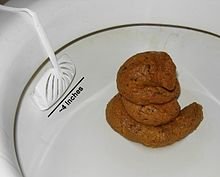
Human feaces kept for drying
Source
The human feaces, shit or ‘human stool' as more often used in the medical field, are the solid or mostly semi-solid remnants of food taken through the oesophagus or throat that could not be absorbed or digested in the smaller intestine, therefore was worked on by various bacteria and sent to the large intestine in a ‘rotten' state. In synopsis, it is the food that we eat that wasn’t digested. It varies in colour(it comes in hues of brown, light brown, yellow, deep yellow and seldom green), sizes(which is dependent on the age of the human), texture(that is, the moisture content of the excreta) as you always see. Altered by bacteria, it contains bilirubin and dead epithelial cells from the lining of the gut. The metals contained in stool are Calcium(Ca), Magnesium(Mg), Zinc(Zn), Copper(Cu), Nickel(Ni), etc as opposed to the Nitrogen, Potassium, Sulphur, phosphorus, etc excreted via the urine.
What can these feaces be used for?
Their uses actually determine the later stages of their processing. They can be used as/for;
• Fertilizer
Human faeces have historically been used as fertilizer for ages in various forms as sewage sludge, fecal sludge or night soil(hold on!, these are just terms for dried shit and wet shit). In Thailand, human excreta are reimbursed into agriculture-intended soils as supplements to the already made commercial fertilized soils. However, safe measures are always employed to avoid agricultural ill-effects or possible health risks which has already injected over 1.5 billion people with the helminthiasis disease in developing countries.
• Fecal Transplant or Fecal Bacteriotherapy
This is the use of faeces to treat diseases such as irritable bowel syndrome by transplanting of fecal bacteria from an healthy individual into the patient. This is a proven method of re-etablishing the normal gut cultures of gut flora that could have been destroyed by antibiotics or some medical treatment which can therefore improve the physiology of the recipient gut.
• Biogas Production
This is the harnessing of the energy potentials in the human defecate to produce useful biogas that can be used for domestic and industrial purposes.
For the purpose of this post, we are delving intensively into the processes involved in utilizing faeces for biogas production. But first of all, what is biogas?
BIOGAS typically refers to a mixture of different gases produced by the breakdown of organic matter in the absence of oxygen. Biogas can be produced from a number of raw materials which includes agricultural wastes, plant materials, green wastes, as well as sewage -semi-solid faeces. Later on, we will dwell on sewage which is the focal point of this post.
However, Biogas is produced by anaerobic digestion of methanogen or simply anaerobic organism, which ingest material into a closed system or fermentation of biodegradable materials. This closed system is called an Anaerobic Digested, Biodigester or Abioreactor.
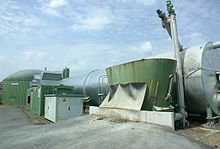
Biogas carrying pipes
Source
Biogas is primarily Methane(CH4) and Carbon dioxide(CO2) and has small amounts of Hydrogen Sulphide(H2S), moisture and Siloxane. Methane, Hydrogen and Carbon dioxide which constitute the HydorCarbons are the gases that allow Biogas to be used and fuel to power vehicles, heating, cooking, etc.
Biogas are produced either through Landfill Gas or Anaerobic Digester. The Landfill Gas(LFG) involves the breakdown of biodegradable wastes into a landfill due to chemical reactions and microbes while Anaerobic Digester is a Biogas plant where anaerobic digestion takes place by digesting gas through several process to produce Biogas.
Sewage are solely processed through the anaerobic digestion processes to produce Biogas as the LFG method does not suit it requirements.
Before we go into the Biogas production process of the anaerobic digester, let’s take a look at the sewage.
Sewage
Sewage is a domestic or municipal wastewater containing contaminants like greywater from sinks or showers, blackwater from human wastes, soapy water, etc. In the sewage, our concern here lies entirely with the blackwater human wastes which the post focuses on.
Now let’s get back to the anaerobic biogas production processes.
The processing of human waste in sewage to Biogas involves three basic stages which are vastly discussed below.
I. Sewage Treatment
Sewage treatment is the process of extracting contaminants gotten from human wastes. These contaminants are removed by physical, chemical and biological processes which takes place in a specialized wastewater factory. Sewage treatment takes place in three processes, viz;
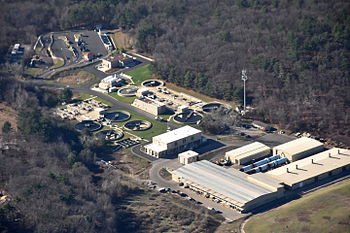
Sewage treatment plant in Massachausetts, USA
Source
Primary Treatment: In this stage, the sewage is temporarily held in a quiescent basin where heavy solids can settle to the bottom while less dense components like oil or grease float to the surface. The settled and floating materials are hitherto removed and the remaining liquid will be subjected to secondary treatment.
.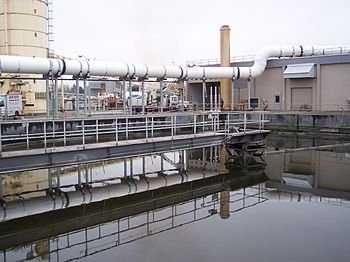
Primary treatment tank, Oregon, USA
SourceSecondary Treatment: This involves the removal of dissolved and suspended biological matter, which is easily done by native water borne microorganisms in a managed or cultured habitat. This usually requires a separating process to remove the organisms from the treated water prior to discharge for tertiary treatment.
Tertiary Treatment: Basically, this is just any other process more advanced or higher than the primary or secondary treatments before it can be sent for further processing.
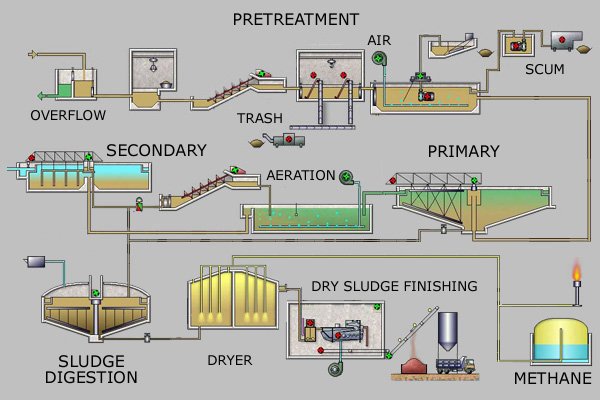
Simplified diagram showing process for typical large scale treatment plant
Source
II. Sewage Sludge
Sewage sludge or wastewater refers to the residual semi-solid materials that are formed as a by-product of sewage treatments of domestic wastewater or faeces.
When the fresh sewage enters the settling tank in the primary treatment phase, an approximate of 50% of the suspended solid matter settled out in an hour and a half. Here, the sludge treatment focuses on reducing the sludge weight and volume by drying or by any other form of non-excessive hearing to reduce the moisture content of the sewage to become sludge.
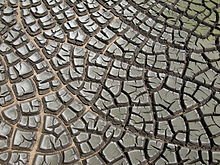
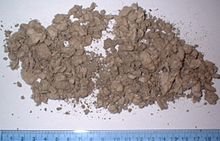
Dried Sludge ready for anaerobic digestion
Source
III. Anaerobic Digestion
As part of the processes that finalises the conversion of human wastes from faeces to dried sludge to Biogas, anaerobic digestion involves the collection of processes by which microorganisms break down biodegradable materials in the absence of oxygen. When converting dried sludge to Biogas which comprises of mainly Methane, Carbon dioxide and Hydrogen, anaerobic digestion employs a number of processes. However, these Anaerobic Digestors can however be designed to operate in various temperature conditions, process mode, volume type, etc. Meanwhile, there are four main stages that finalizes the production of Biogas in the digester, these processes are Hydrolysis, Acidogenesis, Acetogenesis and Methanogenesis. The general process can also described by a chemical reaction, where organic material which is glucose or human waste, biochemically digested into Carbon dioxide(CO2) and Methane(CH4) by anaerobic microorganisms.
. 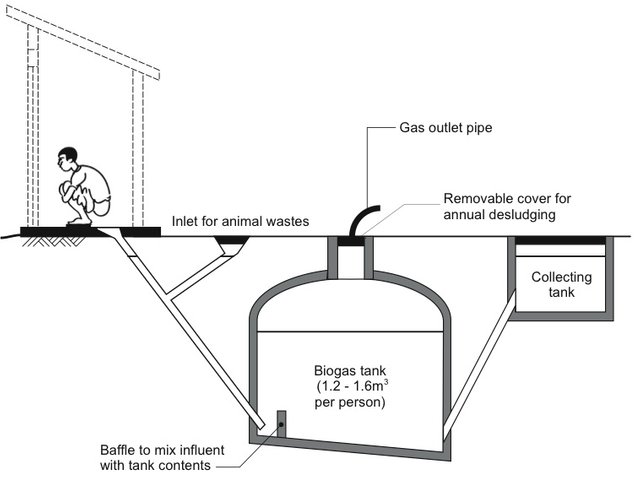
Schematic of an anaerobic digester
Source
Equation of Reaction: C6 H12 O6 = 4CO2 + 3CH4
• Hydrolysis:
Biomass(Sewage Sludge) is made up of large organic polymers, for the bacteria in the Biogas plant(anaerobic digester) to harness the energy potentials in the materials, the biological large organic chains must be broken down into smaller parts. Hydrolysis is therefore the breakdown of these chains into smaller molecules and the dissolving of these molecules into solution(Liquidated compound). Hydrolysis is therefore responsible for the breakdown of these complex organic molecules into simpler molecules.
Acetate and hydrogen produced herewith, are directly used by methanogens. Other molecules with longer chain structure than hydrogen are directly used by the methanogens. These methanogens are microorganisms that produce Methane as a metabolic product in anaerobic conditions. This Methane is an essential part of the combustible Biogas.
• Acidnogenesis:
This is the biological process of further breakdown of the remaining components by acidogenic(fermentation) bacteria. Here, Ammonia(NH3) is created along with Carbon dioxide(CO2) and Hydrogen Sulphide(H2S). This process can also be compared to Souring Milk by acidifiation through bacteria fermentation. It is pertinent to note here, that these gases produced here are also essential components of Biogas.
• Acetogenesis
Acetogenesis is the third star of anaerobic digestion characterized by creating of simple molecules through the previous acidnogenesis stage. These molecules are then digested by Acetogens to produce large acetic acid, as well as Carbon dioxide and Hydrogen.
• Methanogenesis
Methanogenesis is the terminal stage of anaerobic digestion. After acetogenesis, methanogens use the intermediate products of the preceding stages and covert them into Methane, Carbon dioxide and Water. These components make up the majority of the Biogas emitted from the system. The remaining indigestible materials and dead bacterial remains that cannot be harnessed constitute the material called Digestate.
The three main products gotten are Methane, Carbon dioxide and water. Water and Carbon dioxide are neglected while Methane is collected.
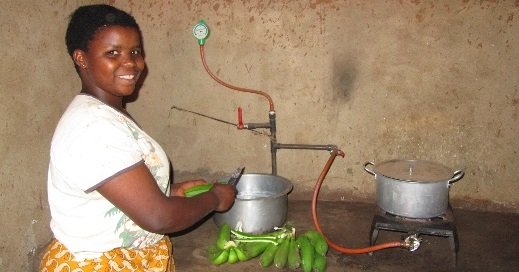
Using Biogas as an effective and cheap source of energy
Source
Domestically, various homes are using Methane as cooking gas in Vietnam, India and various parts of Asia. The energy is cleaner, cheaper, effective and renewable. Several homes in Asia cut costs by reproducing cooking energy from their faeces. Interestingly, this is can be easily done by simply modifying the modern or sewage collector to absorb or tap the methane produced in the underground sewage tank.
Here, the gas can be easily tapped from a locally made biodegradable decomposing matter(not only faeces), in the absence of oxygen by anybody as shown below
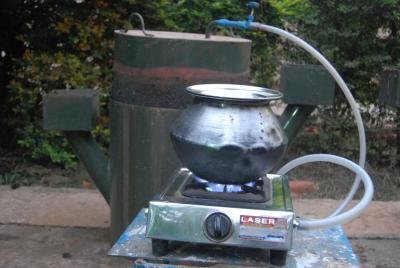
A locally made Biogas Equipment
Source
Biogas is a serious competitor for Solar energy as the solar energy needs a high level of tech knowledge and skilled manpower, not mentioning the cost.
Biogas is the future of renewable energy, a cleaner, effective, cheaper, easily available source of power, it is the most beautiful thing to ever occur to mankind after electricity.
References:
https://en.m.wikipedia.org/wiki/Anaerobic_digestion
https://en.m.wikipedia.org/wiki/Human_feces
https://en.m.wikipedia.org/wiki/Biogas
https://www.ncbi.nlm.nih.gov/m/pubmed/11886091/
http://www.smallstarter.com/browse-ideas/how-to-start-a-biogas-production-business-in-africa/
Hello @rexdickson, @steemstem will not support articles made with copyrighted image(s). You can also check this blog post by @steemstem here and this guidelines here for help on how to be a member of @steemstem. Please also check this blog post from @steemstem on proper use of images devoid of copyright issues here.